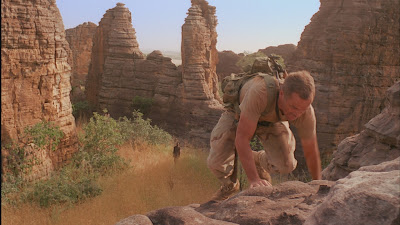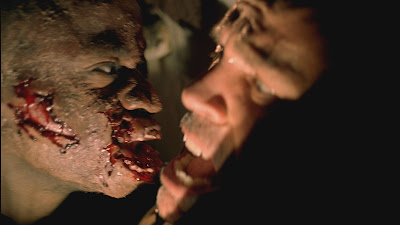I recently had the privilege of interviewing Amir Moallemi, the executive producer of the "zombie road film" The Dead, coming to theaters this summer, directed by brothers Howard and Jon Ford and filmed exclusively in rural Africa...
SOMETHING MOST DREADFUL: Amir, can I just start by saying the African filming locations in The Dead look amazing.
AMIR: It was one of those things where the idea for the script has been resonating with Howard and John for 20 years. Howard and Jon are commercial people and a lot of the commercials were based in Africa so they have a lot of contacts and friends there. And obviously, it’s one of the most beautiful continents in the world. Howard would always say to me, “When I’m shooting a commercial, it’s like a mini movie.” And he had such enthusiasm for them. Yeah, it was business, but there was a lot of passion behind them. And we just started talking one day about future films and he came up with the idea that… He and Jon had this script in the pipeline, sort of just sitting there so they just sort of polished it up and said, “Let’s actually bring it to Africa”, because A), they’ve got structure there, and B), they’ve got such good knowledge of that region that they were able to shoot a film in the Sahara Desert, you know, with some of the best vistas that hopefully people have seen.
SOMETHING MOST DREADFUL: Even given that, from what I read in your press kit about the making of The Dead, it sounds like there were quite a few surprises, as far as the actual logistics of filming in the West African countries of Ghana and Burkina Faso, which I haven’t actually heard of.
AMIR: It’s surprising how many people haven’t actually heard of it. But it’s proper Africa. A lot of people, when they go to shoot in Africa, they go to South Africa. There’s some great infrastructure there, they’ve got some beautiful hotels. We didn’t really want to do that. We were sort of like guerilla filmmakers in effect. We’re fans of the genre anyway. There are so many films out there that say they’re independent films but there’s a studio connection somewhere. Behind the scenes, there’s always a producer who’s connected to one of the studio, something like that. We weren’t. We were just three guys who went out there and said, “Let’s go and make a film,” raised the finances privately and just went and shot this movie. So, yeah, it was a bit of a gung ho attitude, but there were a lot of issues. Obviously, in South Africa it would have been much easier, but it comes at a cost. And also, we were trying to sort of bring the traditional Africa that Howard and Jon knew from traveling through that region. And we had certain issues, for example, Rob Freeman (lead actor), was nearly three days from death by malaria. He contracted malaria and just collapsed one day on the set. It was literally that close, if he had not been treated within a couple of days. He’s such a fit guy, I mean, he’s probably one of the fittest and healthiest people I know and he didn’t show the signs of it. People who were less fit would probably have shown signs earlier on. And when he went to the hospital he was on a drip for a week. He was in really bad shape. Directors Howard and Jon got robbed on the first day as well. I remember Howard phoning me up in London, he said, “I need another bank card. I just got robbed at machete point. And we had another issue where the camera blew over. It was weighted but there was a gust of wind from nowhere that just blew it over and cracked the casing, about $20,000 worth of damage to it. So we were finding it tight anyway, and then things like running out of food, it was a very ambitious project and I think the whole logistics of it, yeah, looking back on it, it was hard. But we got through it. That’s the most important thing.
SOMETHING MOST DREADFUL: Howard and Jon described it as “hell on Earth”. How did you all manage to stay motivated enough to get through it?
AMIR: To be honest, it was tough because a lot of the time I was based in the UK. My plan was to actually go out there a lot, you know, as executive producer, getting involved on it. An executive producer is usually someone who does the financing, but in this case, because it was such a close-knit independent film, everything was hands-on. I was buying props, etc, things like that. So I was supposed to go over there for a lot longer than I actually did. And what actually happened in the end, because of all of these issues with insurance and things like that, I was spending a lot of time in the UK. I’d be speaking to Howard every day and you could sort of like slowly listen to his voice dwindling. I’d phone him up and I’d be enthused and say, “How did the shoot go today? And I’d hear, “Oh, we had this problem, we have this, we need more money.” I sort of prepped him and said, “Look, we’ll get through this. Stay positive, think of the end result.” I suppose that’s what got him through, the fact that we were doing a project, which, you know, we weren’t working for a studio. We were working for our friends and family who had helped us finance this. So I suppose they were also making the movie that they had always wanted to make. It was a passion project, to a certain extent, like any film is, I suppose. We just had to fight through it. There wasn’t really much we could have done. We could have given up but I think it was a strong mind that said, “Let’s just get through it. And lucky we did. There were some very close times where the guys were actually thinking, “Should we pack this in?” But in the end, we just decided to just go for it and that’s what motivated us, I suppose, the fact that every day we were shooting was a day closer to finishing it. You kind of go on autopilot, I suppose. Luckily, we got there. How we got there, I’m still not 100 percent sure, but we managed to. “No pain, no gain” is a bit of a cliché, but it really is true.
SOMETHING MOST DREADFUL: Like the saying goes, “What doesn’t kill you makes you stronger.”
AMIR: Exactly. And all of these analogies certainly came true. But we got there in the end. That was the most important thing.
SOMETHING MOST DREADFUL: One thing I found interesting, reading about The Dead was how some of the areas in Africa where you filmed were so remote that the locals there had never seen outsiders or a camera. I can only imagine how bizarre that was from their perspective, having not only filming happening there but also seeing zombies running around.
AMIR: It was a really funny sort of experience because when we were filming there were a lot of people there who had never been involved with films so they were just intrigued to see the filming process going on. So that was sort of a learning experience on its own. Not having any Western culture over there or ever seeing a camera, that was shocking to them. But it was surprising how enthused they were. They really got behind it. Obviously, we explained what we were doing. And I have to say, a lot of them really got involved. One guy, we actually got him a donkey because he was walking five miles a day to work. You look at things like that. Going back to thinking about how tough our shoot was, you look at someone whose lifestyle is like that, they’re walking five miles a day to earn 50 pence a day. You look at that sort of commitment they’ve got and it was nice to be able to have them help out in the film. But they did find it really strange. They obviously found it a cultural difference, seeing people from the West coming over and making a film. And they obviously thought the zombies were quite interesting. They were very intrigued in terms of the way we made the zombies up and the makeup, etc. But, yeah, they were really enthused and really got behind us so it was a really nice experience.
AMIR: Everything apart from a couple of headshots was makeup. That was one of the things the directors wanted to go to. Certainly the tendency in recent movies is, I think, CGI is overdone. In certain films, “popcorn films,” it works, but what we were trying to achieve, we were trying to have a proper storyline and use some really great vistas. I think if you use CGI it becomes a bit gung ho and it wouldn’t have really achieved what we were trying to achieve as well. We didn’t use any CGI. Everything was makeup, quite basic stuff. But we had talented guys. We had Max Van De Banks and Dan Rickard, a couple of really talented individuals who did a really great job on it. So, yeah, we tried to make everything with a minimalist approach which I think was important. CGI wouldn’t have fit in with the line we were taking on the whole movie. It was a proper storyline. Very rarely does a zombie film have a real strong storyline with great sceneries. So we needed to make sure the zombies were within the fit. Because although it’s a zombie movie, we’re finding that it’s attracting a lot of other people who aren’t necessarily fans of the zombie genre, but who might also like to see a storyline of a buddy movie type of thing. Or they’re looking at the great landscapes that Jon captured on film.
SOMETHING MOST DREADFUL: You mention in your press release that a cannibal visited your set.
AMIR: Yeah, that was interesting. We were filming a scene and a guy rode by on his bicycle and stopped to see what we were doing. He spoke to the translator and the translator told Howard that he was an actual cannibal. He was intrigued by seeing the zombies eating people. And he looked at Howard and said, “I’ve never tried white meat.” And he sort of laughed but it was one of those things where we were thinking, “Is he serious?” So it got a bit dark at that point. It was quite a funny story but it became for a second there a little bit daunting. We sort of swiftly moved on after that.
The Dead will be in theaters this summer and will be released on DVD through Starz/Anchorbay.
THE DEAD
www.thedead-movie.com




No comments:
Post a Comment